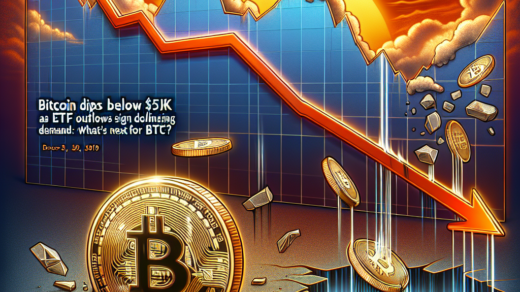JPMorgan Reports Significant Outflows in Ether Spot ETFs Compared to Bitcoin: What It Means for Investors
In a recent research report, JPMorgan highlighted a stark contrast between the performance of ether (ETH) spot exchange-traded funds (ETFs) and their bitcoin (BTC) counterparts. Since their launch on July 23, 2023, ether ETFs have experienced net outflows, amounting to approximately $500 million. In contrast, bitcoin ETFs have seen impressive net inflows exceeding $5 billion earlier this year. This disparity raises questions about the current state of the cryptocurrency market and the factors driving investor behavior.
The Launch of Ether and Bitcoin ETFs
The ether ETFs, which began trading in the U.S. six months after bitcoin ETFs, have struggled to attract investors. The five-week period following their launch has revealed crucial insights into the differing dynamics between these two leading cryptocurrencies. While the ether ETFs have faced significant challenges in drawing institutional and retail interest, bitcoin ETFs have solidified their status as a preferred investment vehicle for many.
Understanding the Factors Behind the Outflows
JPMorgan’s analysis pointed out several reasons for the underwhelming performance of ether spot ETFs. One of the standout factors is bitcoin’s “first mover advantage.” Being the pioneer in the cryptocurrency space, bitcoin has established a solid reputation among investors, offering a perceived stability that ether currently lacks.
Another contributing factor is the absence of staking options for ether ETFs. Staking has become an attractive feature for many cryptocurrency investors, as it allows them to earn rewards on their holdings. Without this capability, ether ETFs may appear less appealing, particularly to institutional investors looking for ways to optimize their returns.
Additionally, lower liquidity in ether markets compared to bitcoin means that large trades can significantly impact prices, further deterring institutional participation. This combination of factors has resulted in the staggering outflows observed in ether ETFs.
Unexpected Outflows from Grayscale’s Ethereum Trust
One of the most surprising revelations from JPMorgan’s report was the outflow of $2.5 billion from Grayscale’s Ethereum Trust (ETHE). Initially, the bank had projected these outflows to be around $1 billion as Grayscale transitioned from a closed-end fund to a spot ETF. The stark difference in projections indicates a lack of confidence in the ether market, raising alarms about the future of ether investments.
In response to the significant outflows from ETHE, Grayscale has launched a mini ether exchange-traded fund. However, this new ETF has only managed to attract $200 million in inflows, further underscoring the challenges facing ether investment products.
Shift Towards Combined ETFs: A Potential Solution
As a result of the weaker demand for ether ETFs, JPMorgan has observed a growing interest among asset managers to file for combined ETFs that provide exposure to both bitcoin and ether. This approach may help to mitigate the risks associated with investing in a single cryptocurrency and attract a broader range of investors. By diversifying their exposure, asset managers could potentially enhance the appeal of these products.
Current Ownership Landscape of Bitcoin and Ether ETFs
According to JPMorgan, institutional and retail ownership of spot bitcoin ETFs has remained stable since the first quarter of 2023. Retail investors now hold approximately 80% of these ETFs, suggesting that the majority of new investments have been made by individual investors, either directly or through investment advisors. This trend highlights the growing importance of retail participation in the cryptocurrency market.
The Future of Ethereum Investments
Despite the current challenges facing ether spot ETFs, there is still potential for growth in the Ethereum ecosystem. Innovations such as Ethereum 2.0 and the expanding decentralized finance (DeFi) sector could bolster investor interest in ether. As the market matures and new use cases for Ethereum emerge, the overall sentiment may shift, providing a more favorable environment for ether investments.
Conclusion: Navigating the Cryptocurrency Landscape
The disparities in performance between ether and bitcoin ETFs serve as a reminder of the complexities within the cryptocurrency market. For investors considering exposure to digital assets, understanding the nuances of each cryptocurrency and the associated investment vehicles is crucial. While bitcoin currently enjoys a dominant position, developments in the Ethereum network and market dynamics could reshape the landscape in the coming months.
As the cryptocurrency market continues to evolve, staying informed is essential. For those interested in investing in Ethereum or other digital assets, resources such as How To Buy Ethereum and What is XRP provide valuable insights into navigating this dynamic environment.
In conclusion, while ether spot ETFs may be facing challenges today, the potential for future growth in the Ethereum ecosystem cannot be overlooked. As innovations emerge and the market matures, investors should keep a close eye on developments that could impact their investment strategies.











